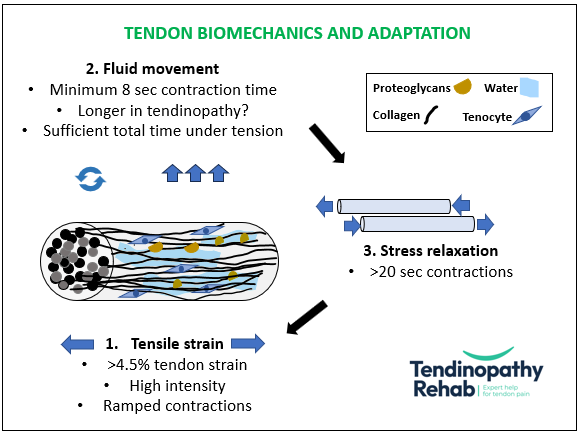Biomechanics of tendon adaptation
Tendon adaptation is complex
I will
discuss here some of the key mechanisms that we as clinicians can tap into to maximise
tendon adaptation.
For details
of tendon loading for adaptation and rehab join me in my brand new course:
Tendinopathy Rehab: Structured Frameworks and Practical Strategies in
Melbourne, 3rd and 4th of May:
https://www.tendinopathyrehab.com/clinicians-offering
An online version will be available soon! ETA April 2025!

We can
get tendons stronger
What has
become clear over the last few years is that tendons are super responsive to
loading. They will get stronger if you load them in the right way, just like a
muscle. The key factor that has gained attention is exercise intensity which
leads to more tendon strain, therefore, more adaptation.
However,
there is more to it. There are three key mechanisms I want to highlight,
including tensile strain, fluid movement and stress relaxation. You can think of
them as a cycle. See the figure.
First, you
strain the tendon by applying a tensile load.
Second, you get thinning of the tendon or ‘lateral strain’. This thinning depends on Poisson’s ratio which is lateral strain divided by axial strain. Axial strain is just stretch along the axis. Lateral strain is thinning occurs as you stretch it axially. Just like an elastic band gets thinner as you stretch it. This thinning causes pressure on the viscous or fluid part of the tendon. This pressure forces some of the free and bound water to move – either redistributed around the tendon or pushed out of the tendon. The fluid movement may cause shear stresses that contribute to adaptation.
Third, you
get a change in mechanical behaviour over time as the tendon is loaded. One
expression of this is called stress relaxation, where the tendon strains more
for a given force. This viscoelastic behavior is enabled by fluid movement.
That is, fluid movement probably enables greater load on the elastic (collagen)
components and more sliding at different levels (between fascicles and between fibrils).
This stress relaxation leads to more uniform loading of the tendon, but importantly,
it also leads to more strain – so you see where are now back to our first
mechanism.
All these
loads place forces on tenocytes (tendon cells) which then signal to allow the
tendon to get stronger. Here are some tips on maximise each of these mechanisms.
Tensile
strain: To maximise
tendon strain we use high intensity contractions, but they need to be ramped.
Contract quickly and the ‘hydraulic stiffness’ mechanism kicks in. That is, the
bound water part stiffens, and the elastic collagen component sees less load.
Fluid
movement: Think
about this as reducing fluid in the tendon to enable more load to be
transferred to the elastic collagen part. This is particularly important in
pathology where we see increased water content. Current evidence in humans
suggests even with 8sec contractions we get significant fluid movement as long
as they are intense and we have sufficient time under tension.
Stress
relaxation: This is
an increased strain for a given force that occurs whilst a contraction is happening.
It won’t happen unless we have some fluid shift, which then enables more
sliding at different tendon hierarchical levels. Current thinking is longer
contractions may be better, but most of the evidence is from animals or basic
science studies.
Thanks for
reading. My next instalment in this series will be a post on what type of
specific exercise strategies to use to maximise tendon adaptation at different
stages of rehab for a tendinopathy.
Acknowledgement: I would like to acknowledge that parts of the figure are from the PhD thesis of my past (and very brilliant) PhD student, Eman Merza.

Connect with Prof Peter & the Team
Book a consultation
-
Visit Peter at our Richmond Clinic
-
Via a Telehealth session
-
132 Bridge Road, Richmond 3121, Melbourne Australia
